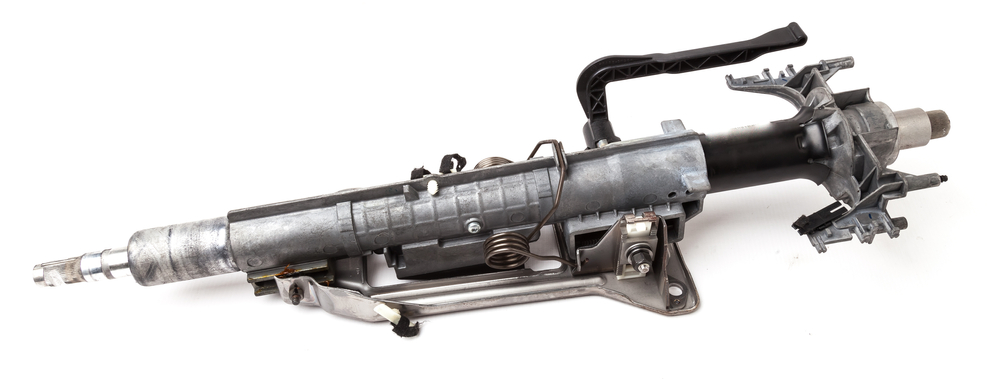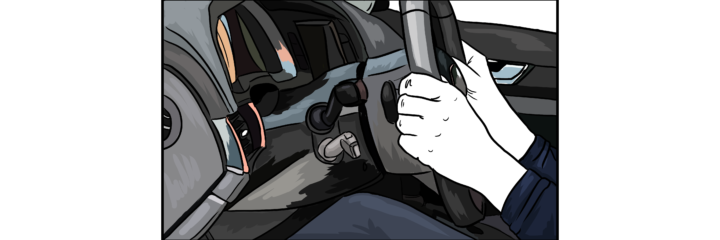The steering column is a vital component to the everyday function of your vehicle – connecting the steering wheel to the car’s internal steering mechanism, allowing for control of direction through turning. Once a fairly simple piece of hardware, it has undergone much improvement over the years to become far more complex.
This translates to greater function, but with increasing complexity comes an increasing number of issues that can go wrong. Most modern vehicles, though excluding heavy-duty trucks and SUVs, operate on a power-assisted rack and pinion steering system. This means that the steering wheel is connected to the car by the steering wheel column.
Hard-wearing and long-lasting, you generally should not have to worry about replacing your steering column during the normal lifetime of your car. Problems and malfunctions can happen, however, and you should be vigilant for any changes to your experience when driving. We will cover here a number of the most common warning signs of a bad steering column, and what they may mean in terms of specific issues and fixes required.
1. Steering Wheel Misalignment
In normal operation the steering wheel should be able to return to a neutral, centered position easily, where the wheels are facing ahead with no adjustment needed by the driver. This should happen automatically and is called “steering returnability.” If you find that, when you turn a corner, the vehicle seems to continue turning without straightening up until you correct the course, this is a problem that needs to be addressed.
This can be caused by a number of issues, but is commonly down to a steering gear that is too tight or improperly adjusted. This may be the result of a technician or mechanic attempting to remove excess play, or “looseness,” from the wheel, so be aware if the problem has arisen after a stay in the shop. There are a number of other causes, however, and the issue is serious enough that we recommend you seek the services of a professional as soon as you become aware of it.
A fairly comprehensive and in-depth guide on this issue can be found here for further research.
2. Unexpected Sounds
A common sign of steering system malfunction, this may not be specific to the steering column, but often is. In a healthy vehicle the steering should be smooth and silent, though issues with the gears and bearings in the steering column can cause grinding or clicking noises. They may not be constant at first and you may only notice them intermittently, though ignoring the problem is a guaranteed way to see it worsen over time.
You should try to take note of the specific nature of the noise you hear, as it may be helpful in diagnosing the problem. For example, a whining or screeching sound is usually indicative of a problem with the power steering, as opposed to the steering column.
The cause of this issue may be as simple as a build-up of grit and dirt, but could be more serious. As always, a qualified mechanic should be your first port of call, before it can evolve into wallet-busting damage.
For more on the potential components that may be affected, we recommend you look at this article from Babylon Honda, which explores the issue. This article by yourmechanic.com may also be useful in determining the problem.
3. Difficult or Stiff Steering
The modern power steering apparatus is designed to make steering your car smooth and easy. A bad steering column may be to blame, however, if you experience a sudden difficulty in turning the wheel. This problem can also manifest as rough or uneven steering, where the steering wheel pops or grinds when you turn it.
There are many moving parts that make up the steering column, and if these become restricted it can translate into a poor steering experience. The universal joint is one of these, and as it fails it may result in binding that not only stiffens the wheel, but also results in a restriction in the full range of movement. This can be a simple fix, but also a very dangerous problem to leave unattended, as it is likely to worsen over time.
This issue is not limited to the steering column, though it may be a prime suspect. You will want to consider many other causes and, as always, our advice is to get the problem seen by a professional as soon as possible.
4. Loose Steering
The counterpart to the above problem. This is known to professionals as “steering free play” and is characterized by a loose-feeling wheel and unresponsive turning. A bad steering column can be a cause, which can be gaining increasing elasticity through general wear and tear. It can also be a cumulative effect contributed to by a number of steering system components, though the steering column is often the one to consider. It often arises as part of the general aging of a vehicle but is not a completely benign problem and will not resolve itself, so is worth your attention.
This problem can ruin a good driving experience, but more than that, it may be a danger as it lessens the responsiveness of the vehicle overall, which can mean the difference between a near-miss and an accident. This should be motivation enough to get your vehicle attended by a professional, before the worst can happen.
For a more in-depth look at the causes and fixes for loose and unresponsive steering, we recommend you take a look at this article from hendersonslineup.com, which is quite comprehensive.
5. Steering Tilt Malfunction
Many modern vehicles offer the utility of an adjustable steering wheel, allowing the drivers to tilt, raise or lower the wheel to an ideal and comfortable position. Once moved to the position desired, the wheel should then lock into place and remain so until you want to move it again. If this lock does not engage and the wheel remains motile then this indicates a failure in steering column components.
The problem is not common, but should be taken seriously when it arises; the vehicle should not be driven with an unlocked steering wheel as this is both illegal and extremely dangerous. This obviously makes it difficult to transport the vehicle for repair, so a break-down service should be considered as an option to get it to the shop.
6. General Wear and Tear
Not strictly a symptom, but a consideration that should be kept in mind for the safe everyday operation of your vehicle. As we have stated earlier, there are many moving parts that make up the modern steering column. Dirt, grit and grime can be a problem that builds up silently.
This can lead to most of the issues stated above, which may occur at inconvenient times. It is our recommendation that you preempt this by having your vehicle serviced regularly by a registered professional. This not only leads to reliable function, but also can help save money in the long run by maintaining the health of your components for a longer time.

FAQ
How Much Does a Steering Column Cost to Replace?
The specific cost of a steering column can vary based upon the model of your car, the cost of labor and whether the part you are purchasing is new or used.
The part itself can range between $100 used or $300 new. The most significant cost will be labor as the work required is fairly intensive, taking multiple hours. For this you may find a price ranging from $200 to $600. Overall, then, you may expect a total cost of $300 to $900.
When Should I Replace My Steering Column?
There is no general guideline on the overall lifespan of your steering column, but you should not expect to replace it for the full lifetime of your vehicle. This does depend on frequency of use, of course, and does not factor in unexpected malfunction. If any of the above issues arise then replacement should be considered, if your mechanic recommends it.
Until Next Time
A bad steering column can cause a myriad of dangerous problems, but by now we hope you should have an idea of the symptoms to look out for and the solutions you should follow. As we have recommended many times, a registered mechanic is the first person you should speak to should any issues become apparent.
Until next time – safe driving.



